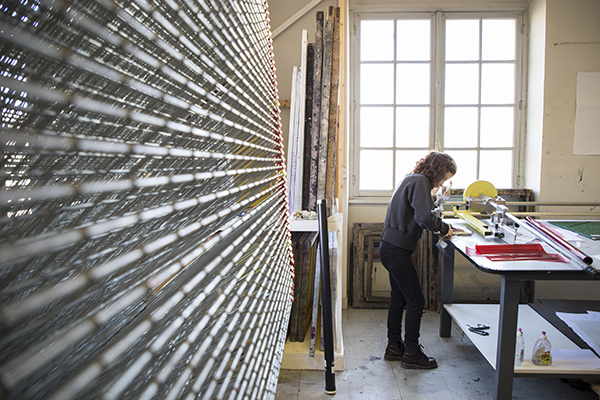Facilities
The students have at their disposal classrooms, workspaces and a 110-seat amphitheatre for lectures, talks and conferences. In addition, the school has a residence for welcoming artists and a studio for visiting professionals.
LIBRARY

At ENSA, visiting the library is considered an essential study activity in its own right.
The library ensures that students have access as much to a cultural heritage as to what is current regarding artistic creation in all its various forms, always closely linked to their lessons. The library is a place favourable to exchange, research, questioning, a place of enrichment and discovery surrounded by many documentary resources.
Library collections
The library offers its users more than 17,000 works on art, design, photography, multimedia, architecture, the history of art and social sciences.
The collection is particularly rich in exhibition catalogues and artists’ monographs. It is currently subscribed to 40 specialist journals (French and international), an abundant collection of old journals, and multimedia resources (DVD, CD).
Digital resources can be consulted from library computers (online newspapers, databases, access to the Encyclopaedia Universalis). In line with current events, it is also a place of information on cultural events, professional life and guidance.
Digital resources can be consulted on the spot at the following address: ensa-dijon.bibli.fr/opac
Documentary Resources Collection
A collection of online documentary resources is available from the website: ensa-dijon.bibli.fr
Opening Hours: Open to everyone 9:00-18:00 (17:00 Fridays).
Lending is restricted to students and staff of ENSA Dijon.
Head Librarian: Vanessa Silvia
The library occupies two spaces: the main library and the study and periodicals room.
EQUIPMENT LOAN
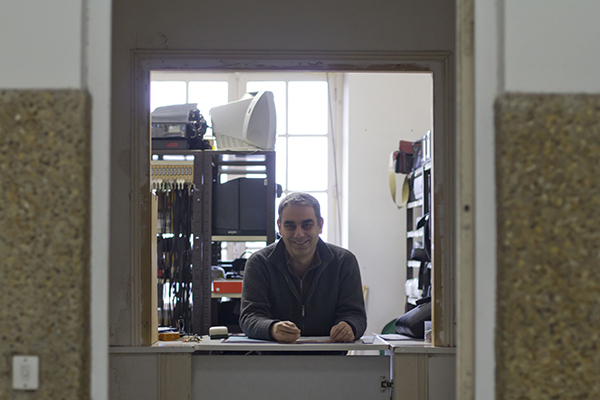
Students can borrow any materials they require in order to complete their work throughout their studies.
Opening Hours: all week 14:00-17:00
Supervisor: François Garraud (materiel@ensa-dijon.fr)
ATELIER DE FABRICATION
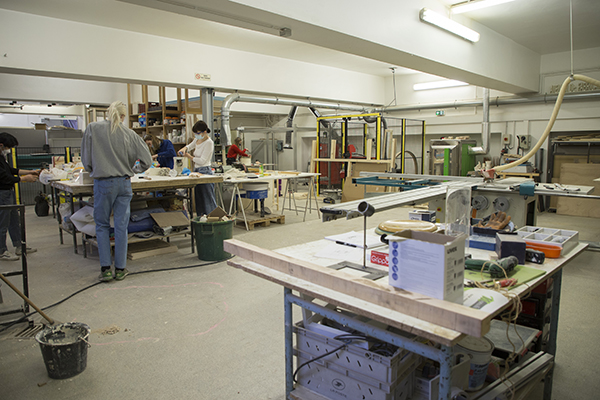
This workshop is available to all students in Art and Design. It is here that they meet, work and exchange on the processes of creation which differ for art and design.
They share the intimate need to create, combined with the desire to contribute to the invention and experimentation of attractive forms in both specialisations.
The workshop, located in the basement of the school, has a surface area of 200 m².
It is an open space wherecreation and know-how mix.Students are supervised throughout the manufacturing process in order to gain independence as technique remains essential to creation.
These spaces are equipped with professional machinery:
- The wood section includesa panel saw, a band saw, a radial-arm saw, circular saw, a computer-driven tracer, a laser-cuttingmachine and a stock of handheldmachines and hand tools
- The metal area contains electricshears, a metal folding machine, a metal cutter, two stations forTIG/MIG aluminum and stainlesssteel welding
- The casting area has a thermal-forming machine, a hollow base for moulding, a computer-aidedmachine for cutting polystyrene,a ceramic oven and a 3D printer.
Students who have learned tobecome familiar with these spaces and their safety regulations canthen experiment with construction techniques involving wood,metal and art materials as a wayof researching and understanding space and volume.
The approach is centered on the individuality of each student to developall his/her potential. It is forvalidating theories. The objectiveis to make the student independent in the workshop to buildand develop their artistic projects, activities, work tools andresearch.
Learning is achieved through the elaboration of well-drafted projects with cost estimates, critical analysis and methodological advice on the feasibilityof projects for 2nd to 5th year students. It is a place wherethinking and producing alternatein order to develop a critical eye.
Material Storeroom

At the centre of the workshop, the material storeroom offers:
- A selection of materialsgrouped into three categories(natural, synthetic and composite)available to students (samples and catalogues).
- Advice on their implementation,necessary for the creative process. It is a center of resources,inspiration and innovation. Teaching the use of a material constitutes a powerful pedagogical toolallowing the study of a project inall its complexity. The studentshould be able to identify and understand the constraints of thesematerials and determine their real limitations: it is from constraint that creativity is born.
Supervisors: Nathalie Vidal & Didier Walterspieler
PRINTING – PUBLISHING

This workshop is open to all students and offers a paying service for laser and inkjet printing. At the beginning of the academic year, all students have a printing credit of €30 (€15 paid by students as part of their matriculation + €15 offered by ENSA).
At any time, students can add credit to their printing account by contacting Francine Vernardet (Villa, 2nd floor) and paying by direct debit or cheque (not folded or cancelled), made out to “Régisseur de recettes ENSA DIJON”. Unused credits are rolled over to the following year for returning students, but are non- refundable for those leaving the school.
Prices are posted in the Printing-Publishing workshop. They are fixed at current prices depending on the document size, type of printing (black & white or colour) and printer used. For special editions (notably large format), the students should ask Eric Marillier beforehand for an estimate, then settle the amount with Francine Vernardet.
Opening Hours: all week
Supervisor: Eric Marillier (eric.marillier@ensa-dijon.fr)
PAINTING WORKSHOP

This workshop is run by various members of the teaching staffthroughout the week. This spacefor practising painting at thevery heart of the school is aboveall a place of production, exchange and meeting around current pictorial approaches.
Opening hours: all week (Access reserved to students in the ARC workshop “Contemporary Practices of Painting”)
Supervisors: Alain Bourgeois, Anne Brégeaut, Bruno Rousselot
COMPUTER GRAPHICS & SERIGRAPHY WORKROOM
It is made up of several work areas devoted to different digital processes. For the useof all students in art and design,it provides them with training in techniques of image processing, post-production, page setting and printing. Compulsory courses are offered to first year students. After whichfollow-up appointments can bemade for your personal projects.
Post-production

For photography, the school hasthree dedicated areas for photographic post-production where you will find installed:
- 2 Apple computers, 2 MacPro Xeon E5 3.7 GHz and a MacPro
- All computers are equipped with Adobe Creative Suite, Lightroom, Capture One
- Profiling and print managementsoftware paired with a spectrophotometer
- 2 large format printers, Epson SureColour SC-P9000 and Epson StylusPro 11880 and a A3+ printer Epson Stylus Photo R2400
- A laminator for PVC media up to 120×240 cm
These areas available all week with appointment.
PUBLISHING
- 20 Apple iMac computers withIntel Core i5/2.7 GHz 21.5”, 2 Apple iMac computers with Intel Core i7/3.4 GHz 27” and 2 Apple iMacwith Intel 3.06 GHz Core2 Duo 24”
- Printing can be done on 2 laser colour printers, one Xerox Docucolor 240 and one Canon C5045i
- A collection of tools necessaryfor staple or glue binding are also available.
- All the computers are equipped with the latest available programmes of Creative Suite Adobe, Lightroom, Open Office.
Sérigraphy
A technique for manual planographic printing, historically close to painting from which it shares pigment use and some supports, serigraphy has broadened its territory over time by integrating, among other things, resources, photographic and digital image.
At the outset destined to reproduce the same image in large quantities, think posters, its use has evolved to become a preferred medium for some artists used in the creation of unique artwork.
Open all week by request made to Philippe Mailhes.
MANIFOLD WORKSHOP

It is at the same time a place for thinking and a platform for CAD design intended for all those who have benefitted from training invarious basic software programs (photoshop, Indesign, Illustrator, Lightroom) with the aim of working on specific teacher assigned projects right through to the creation of these works.
Open only accompanied by a teacher or technician.
Supervisor: Carlos Castillo
COLOUR WORKSHOP
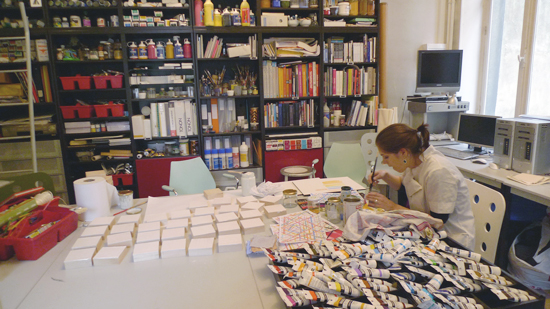
Considered as a true platform of painting technology, the colour workshop aims to allow students to experiment with data from the Material Storeroom withinthe framework of their personalprojects. Experimentation canalso take place during the workshops held by invited artists who bring with them their own methodologies and productionprocesses. One of the firstapproaches consists in a comparative study of nuances proposed by different manufacturersof paint for artists. This approach allows students to question the relevance of nuance in current painting practices.
Material storeroom
The material storeroom is an educational tool that was conceived from the start as a visual and technical database of materials (in the form of leaflets and samples).
As part of the ongoing research into colour, it establishes an interface between our partners in the chemical industry, industries involved with colour, and artists.
Digital practices
The advent of digital technology has provoked a genuine rupture for some artists who must integrate these new devices into their artistic creations. Having recourse to technologies whose standards, codes, colorimetric profiles are essentially defined by the industries of advertisingphotography and cinema, artistshave no other alternative but tobe subjected to these toolsor to continually reinvent them. The role of the digital laboratory is first of all to identifyand list problems and to imaginethe primary elements in methods linked to artistic practices.
Access outside of classes: on request
Supervisors: Alain Bourgeois
STILL IMAGES, PHOTOGRAPHY & POST-PRODUCTION
The photography studio, designed for all Art and Design students, provides a photo/video making studio equipped with a technical grid, background screens and tripods, flashes and generators. It also contains three black and white photo labs equipped to produce larger format prints, a classroom exposed to daylight for viewing digital prints and a room for developing and treating files deriving from digital scans or shots. Photographic equipment – small and medium-sized photographic boxes both digital and analogue format, photographic chambers, lighting equipment – is available to students from Equipment Loan. A post-production studio is also available for screen retouching and calibration (see Computer Graphics and Serigraphy Workroom).
Supervisors: Philippe Mailhes, Pascale Séquer
VIDEO WORKSHOP

This workshop groups together several studios adapted for making audio-visual works. It covers all steps required toimplement your projects: shooting, editing, compositing,spatialisation, producing andtransmitting. It includes a film-making studio, several post-production studios, of which two are specially designedfor compositing and the making of 3D video (stereoscope).
Students have at their disposal sophisticated equipment:
- A room for video classes equipped with 20 workstations (Mac & PC).
- Shooting equipment: HD digital movie cameras, 3D cameras, Go-Pro cameras, audio-digital recorders, voice and directional microphones, lighting, stands, travelling rails
- A film-making studio: motorized technical grid with lighting for photo and video, natural light, technical control room, overlay resources of various colours
- 2 sound booths
- Several workstations for digital editing with the following software: 3D Studio Max, After Effect, Photoshop, Digital Performer, DVD studio pro, Encore DVD, Final Cut Pro, Premiere, Cineform 3D, Smoke, Avid, IRCAM, Melodyne, Metasynth, Peak
- Broadcasting machinery: HD and 3D flat screens, video projectors, amplifiers, multi-format retro-projection screen, spacialisation device for audio 5.1 and multi-screen video splitter
Opening Hours: 9:00-17:00 all week (except during courses)
Supervisors: Luc Adami, Germain Huby, Lydie Jean-dit-Pannel, Lionel Thenadey
SOUND STUDIO
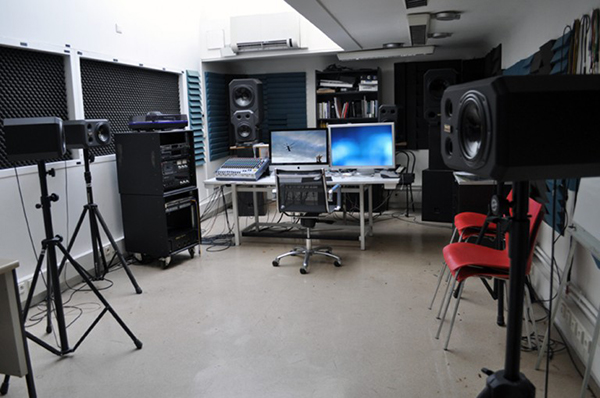
The sound studio is made up of one equipped studio (1 station on Mac – Mac Studio) and a Mac laptop for audio-visual post-production as well as sound and music creation: 8 Tannoy speakers for spatialisation or poly mono (early readers: DAT, vinyl, minidisk, K7 audio cassette) with applications including Live 10 suite, Max for Life Integrated, MAXMSP, Digital Performer 11, Metasynth, Native Instruments Komplete 13.
A second studio is also at the students’ disposition: it is equipped with a sound recording booth using Mac station, recorders Zoom F16 and micro Neumann 103. Available in Equipment Loan is a Mac laptop pre-installed with applications (Max, P 10, Live 10), 2 sound cards, digital recorders (Zoom H4N, Pro, H5, H6), various microphones, 2 Schoeps, 2 Neumann 184, Canon AKG, hydrophonic, binaural, wireless… and around 20 speakers, with or without preamplification, as well as 3 mixing tables, 2 sono combinations (2 HP and Grave chamber). This space is intended for students in both Art and Design options whose works interact with video, sound, installation including proposals from the field of Space Design.
Furthermore, a subscription to IRCAM Forum allows access to various programmes that IRCAM distributes online. The Sound Studio collaborates regularly with the association Why Note and La Générale d’Expérimentation (a concert with students that takes place during the Open Day, at Interface Gallery and other nearby festivals) and other players in the Dijon Cultural Scene. An ARC entitled “The Art of Sound” is run by Nicolas Thirion et Jean-Christophe Desnoux and has a Moog Matriarch, a Tascam Model 16 mixing table and Akai MPC X for experimentation.
Supervisors: Luc Adami, Jean-Christophe Desnoux
AUDITORIUM
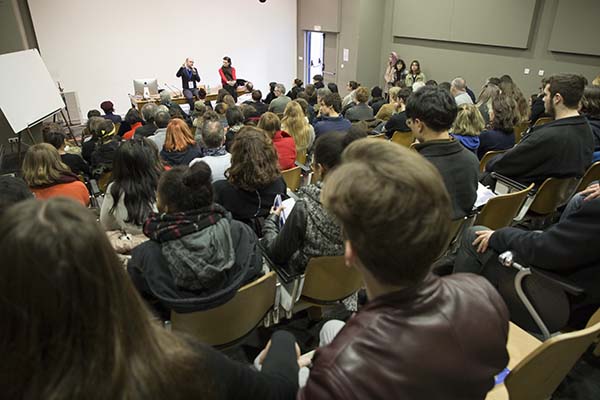
A 110-seat amphitheater hosts lectures, conferences and symposiums.
CAFETERIA
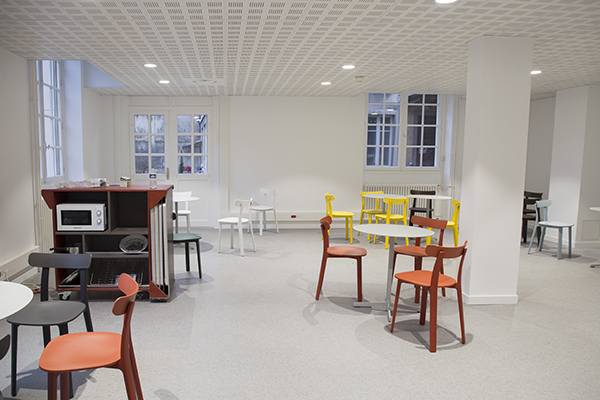
Students have a lunch-room on the ground floor of the establishment.
WORKSPACES

Each promotion (by year and by option) has an assigned workspace.
